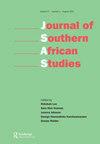边界和过境点:莫桑比克北部一位治疗师的生活
IF 0.7
4区 社会学
Q2 AREA STUDIES
引用次数: 0
摘要
达利亚·特伦蒂尼的书是对莫桑比克北部城市南普拉一位治疗师的生活和实践的叙事探索。书名中的主人公安沙是来自德尔加多角省的马孔德移民,他搬到了楠普拉,皈依了伊斯兰教,并建立了一座“精神清真寺”,在那里,古兰经和草药知识被用来治疗病痛。灵魂附身(majini)是疾病和治疗的核心。作为一个多世界的存在,安莎跨越、航行和谈判了许多边界:种族、地区和宗教之间的边界;在疾病与健康,城市与乡村,精神与人类领域之间。事实上,边界的形象——尤其是“跨越边界”和“边界事件”的概念——为这本书提供了核心概念锚定。全书由22个简短章节组成,分为四个部分。第一部分描绘了安莎的传记,从她在Mueda的童年到她搬到楠普拉,疾病使她发现了她作为治疗师的职业,她皈依伊斯兰教,她动荡的婚姻生活,直到她不幸去世。第二部分探讨了促成和制约安沙实践的社会结构:种族、宗教和国家;治疗师协会和正规卫生部门。第三部分描述了安莎的一些病人的疾病和治疗——通常是不成功的——他们大多数是脆弱的,在西医无法解决他们的麻烦后,他们向她求助。最后一部分以结束语的形式包含两个诗意的快照。每一章都分为几个部分,从田野小品到历史画布再到人类学分析,前后移动。文笔简洁、优美、感人。片断性被接受为一种认知和讲述的模式。虽然这本书的风格属于乔治·马库斯(George Marcus)所称的“凌乱的巴洛克”范式——其反思性的田野故事、中心理论的反复反复和对文化历史的依赖作为剩余意义的提供者,但它最终也通过公开拥抱特质而超越了流派。引言中所宣布的概念上的重复——跨越边界和事件——并没有在正文中被反复排练。用一个音乐的比喻来说,这个主题只在遥远的音调和变奏中重复。在碎片之间的自由相互作用中,Trentini在标题中所强调的生活留下了呼吸的空间,并且从未被一个总体理论框架所束缚。读者可以看到、听到和感受到安莎和她的朋友们。这可能是这本书最大的优点之一。即使在这种激进的开放性和碎片性中,也出现了一些强有力的分析线索。《在安沙》生动地展示了伊斯兰教在南普拉市的当代转变,尤其是在苏菲主义逐渐消亡、瓦哈比主义和伊斯兰主义传播的背景下,围绕着灵魂占有的摩擦。对于那些对德尔加多角的伊斯兰叛乱感兴趣的人来说,这些对逊尼派运动的出现有深刻的见解,这将是宝贵的。这本书还提供了独特的视角,以性别方面的治疗;母系制的转变;沿海和内陆马库瓦社会之间的紧张关系;儿童作为病人的经历;社区警务;南普拉的城市化和社会斗争;的本文章由计算机程序翻译,如有差异,请以英文原文为准。
Of borders and crossings: the lives of a healer in northern Mozambique
Daria Trentini’s book is a narrative exploration of the life and practice of a healer in the northern Mozambican city of Nampula. Ansha, the titular protagonist, was a Makonde migrant from the province of Cabo Delgado who moved to Nampula, converted to Islam and set up a ‘spirit mosque’ in which the Koran and herbal knowledge were used to cure afflictions. Spirit possession (majini) was central both to illness and healing. A being of many worlds, Ansha crossed, navigated and negotiated a number of borders: between ethnicities, regions and religions; between sickness and health, the city and the countryside, the spirit and the human domain. Indeed, the figure of the border – especially the notions of ‘border crossing’ and ‘border events’ – provide the book with its central conceptual anchoring. The book is organised in 22 short chapters, arranged in four parts. The first part charts Ansha’s biography, from her childhood in Mueda through her move to Nampula, the illness that made her discover her vocation as a healer, her conversion to Islam, and her tumultuous marital life, up till her untimely death. The second part explores the social structures that both enabled and constrained Ansha’s practice: ethnicity, religion and the state; healers’ associations and the formal health sector. The third part describes the illness and healing – often unsuccessful – of a number of Ansha’s patients, most of them vulnerable, who turned to her after western medicine had failed to resolve their troubles. The final part comprises two poetic snapshots in the guise of a conclusion. Each of the chapters is broken into sections which move back and forth, from field vignette to historical canvas to anthropological analysis. The writing is sparing, elegant and affecting. Fragmentariness is embraced as a mode of knowing and telling. While the style of the book falls within the paradigm that George Marcus has dubbed ‘the messy baroque’ – with its reflexive field tales, central theoretical riff and reliance on cultural history as provider of surplus meaning, it also ultimately exceeds the genre by openly embracing the idiosyncratic. The conceptual riff announced in the introduction – border crossing and events – is not obsessively rehearsed through the text. To use a musical metaphor, the theme is reprised only in distant keys and variations. In the free interplay between fragments, the life that Trentini has foregrounded in the title is left space to breathe and is never straightjacketed within one overarching theoretical framework. The reader gets to see and hear and feel with Ansha and her friends. This might be one of the book’s strongest virtues. Even within this radical openness and fragmentariness, several strong analytical threads emerge. At Ansha’s vividly illustrates the contemporary transformations of Islam in the city of Nampula, especially the frictions surrounding spirit possession in the context of the gradual demise of Sufism and the spread of Wahhabism and Islamism. There are insights into the emergence of the Ahl al-Sunna movement which will be precious to anyone interested in the current unfolding of the Islamist insurgency in Cabo Delgado. The book also provides unique vistas into gendered aspects of healing; the transformations of matriliny; the tensions between costal and hinterland Makhuwa society; the experience of children as patients; community policing; urbanisation and social struggle in Nampula; the
求助全文
通过发布文献求助,成功后即可免费获取论文全文。
去求助
来源期刊

Journal of Southern African Studies
AREA STUDIES-
CiteScore
1.40
自引率
0.00%
发文量
73
期刊介绍:
The Journal of Southern African Studies is an international publication for work of high academic quality on issues of interest and concern in the region of Southern Africa. It aims at generating fresh scholarly enquiry and rigorous exposition in the many different disciplines of the social sciences and humanities, and periodically organises and supports conferences to this end, sometimes in the region. It seeks to encourage inter-disciplinary analysis, strong comparative perspectives and research that reflects new theoretical or methodological approaches. An active advisory board and an editor based in the region demonstrate our close ties with scholars there and our commitment to promoting research in the region.
 求助内容:
求助内容: 应助结果提醒方式:
应助结果提醒方式:


